Introduction
Wine is the product of fermentation of grape juice. In a broad sense, it connotes alcoholic beverages derived by fermentation of fruits and vegetables musts. Apart from grape, other fruits from which wine is made must carry a notation, for example blackberry wine, pawpaw wine or apricot wine1 (Nwanekezi, 2004). Pawpaw (Carica papaya) is a member of the small family (Caricacea), having four genera and thirty-one species, is a native of tropical America, now spread all over the tropical region of the world2 (Morton, 2006). The fruits are eaten green or ripe, fresh or in salads because of its high sugar content (59%) and thus can be used for wine production3(Anon, 2008). They are also used for making juice, jam and crystallized fruit4 (Seymour et al., 1993). Processed, it has a neutral taste that can be considered improved by the addition of passion fruit to make soft drinks, jam and various preserves5 (Ihekoronye and Ngoddy, 1985). It can also be used in production of latex [6](Wall, 2006). The nutritional composition of pawpaw shows water (75%), food energy calories (92), protein (1.2g), carbohydrate (23.4), fat (1.2), dietary fibre (2.7), minerals (potassium – 396mg, calcium – 63mg, phosphorus – 47mg, magnesium – 113mg, iron – 7mg, zinc – 0.9mg, copper – 0.5mg, manganese – 2.6mg) and essential amino acids [7](Peter et al., 1982).
Coconut (Cocos nucifera) is not really a nut and is the primarmember of the family Arecaceae, it is the fruit produced by the coconut palm 8 (Satyabala, 2003). It is rich in dietary fibre, good for those suffering from constipation; it is also good for building up the body muscles of thin and emaciated individuals. Coconut milk is good for curing sore throat and also helps to relieve stomach ulcer9 (Gladys, 1999). Coconut milk is the liquid that comes from the grated meat of coconut and may be used by drinking it raw, or as a substitute for animal milk in tea, coffee, oil etc. It can be mixed with fruit to make a yoghurt substitute and in general, for baking10 (Rexach, 1995).
Wine, reportedly, had been maintaining health, not only because of their nutritive value, but also because they replace inadequate, impure or otherwise unsatisfactory water supply11 (Hunyinga, 2009). Wine containing less than 10% alcohol is unstable because of their sensitivity to bacterial spoilage. Tropical fruits when compared with grapes are deficient for wine making. The deficiencies stem from lack of sufficient sugar. The percentage sugar contents of tropical fruits have made it impossible to produce wines with alcohol content of up to 10% unless augmented with sugar12 (Turner, 1971).
Early research work by13 Idise (2011) on coconut wine with different recipe of natural yeast and baker’s yeast ameliorated with granulated sugar showed no significant difference and that wine could be produced for consumption within 48hours. Also,14 Awe (2011) produced wine from pawpaw using aerobic and anaerobic fermentation which showed 8.0% and 9.8% alcohol without amelioration.
This research work was carried out with the aim to explore the possibility of producing an acceptable wine from the mixture of pawpaw-coconut milk blend, to investigate the suitability for alcoholic fermentation and storage stability and also to recommend the best proportion in mixing this composite juice using sensory evaluation (ranking test).
Materials and Methods
The pawpaw sample and coconut used as the major raw materials for this work were purchased at a local market in Ilaro, Ogun State, Nigeria. Other materials used were granulated sugar, lime, and distilled water.
Preparation of pawpaw-coconut wine
The pawpaw fruit were weighed, washed, peeled, sliced into two, rewashed, with the removal of the seeds and then reweighed. The fruit were then blended with a sterile blender into puree, ameliorated and then filtered [15](Berry, 2000). The coconut fruit were washed with water, further broken (dehusked) and the brown crust was removed and the meat was then washed and weighed. The meat was grated and thereafter passed through a sterile cheese cloth to get the first extraction of the coconut milk. The shaft was treated with hot water and passed through the cheese cloth for the second extraction and repeated for the third extraction (thin coconut milk). The thin coconut milk was then ameliorated and was added into the pawpaw juice in different proportions as: 90:10, 80:20, 70:30, 60:40, and 50:50 blends respectively. Citric acid, appropriate amount of meta-bisulphite were added, transferred into volumetric flasks, and corked then allowed to stay for 24hours.
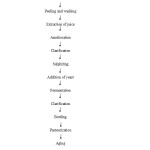 |
Fig. 1: Flow diagram for wine production Click here to View figure |
Fermentation
Standard amount of wine yeast was added to the must in a fermenting Jar. The juice was fermented at room temperature (29 ± 2) for 7days, filtered, bottled and pasteurized at 68˚C for 15 minutes1 (Nwanekezi et al., 2004).
Physico-chemical tests on the wine
The pH, titratable acidity, brix and alcohol percentage were determined using16 (A.O.A.C., 1990).
Sensory evaluation
The sensory evaluation test was carried out using the ranking test questionnaire by[17] Kramer et al. (1974).
Results
The results of the physico-chemical analyses on pawpaw-coconut wine are presented in tables 1 and 2, also in figures 2 – 7. The result of the sensory analysis is presented in table 3.
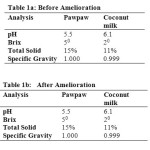 |
Table 1a: Before Amelioration, Table 1b: After Amelioration Click here to View table |
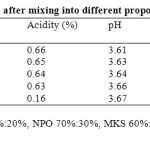 |
Table 2: Analysis of the blend after mixing into different proportions Click here to View table |
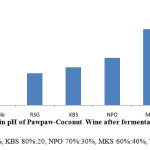 |
Figure 2: Changes in pH of Pawpaw-Coconut Wine after fermentation Click here to View figure |
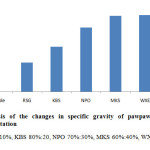 |
Figure 3: Analysis of the changes in specific gravity of pawpaw coconut wine after fermentation Click here to View figure |
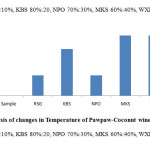 |
Figure 4:Analysis of changes in Temperature of Pawpaw-Coconut wine Click here to View figure |
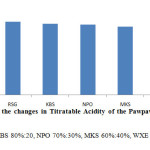 |
Figure 5: Analysis of the changes in Titratable Acidity of the Pawpaw Coconut-Wine after fermentation Click here to View figure |
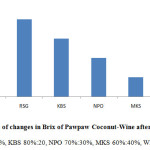 |
Figure 6: Analysis of changes in Brix of Pawpaw Coconut-Wine after fermentation Click here to View figure |
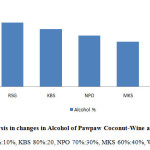 |
Figure 7: Analysis in changes in Alcohol of Pawpaw Coconut-Wine after fermentation Click here to View figure |
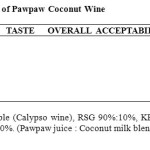 |
Table 3: Sensory Evaluation of Pawpaw Coconut Wine Click here to View table |
D
Table 1a indicated that the pH of pawpaw puree was 5.5 while that of ccoconut milk was 6.1. The brix was 50 and 20, total solid were 15% and 11%, specific gravity were 1.000 and 0.999 respectively. After amelioration, the pH of the two juice dropped to 3.6 and 4.2 respectively while the brix were increased to 180 and 160, total solid to 32% and 28%, specific gravity to 1.0810 and 1.0610 respectively as shown in table 2. It was also observed that after amelioration, the pHdropped, specific gravity increased as the degree of brix was increasing. The increase in specific gravity may be attributed to the fact that an increase in the total solid of a solution increases the specific gravity. Table 2 showed that as the proportion of coconut milk increased, the titratable acidity reduced; the pH was increasing at a constant temperature.
After the seven days of fermentation, the results obtained are shown in figures 2 – 7. The changes in pH, specific gravity and brix of each sample of pawpaw-coconut wine decreased from the initial day to the end of the fermentation. This could be due to microbial succession, available nutrients, sugar and alcohol resulting in the production of acid. This result agree with the reports of[18] Robinson (2006),[19] Anon (2008b),[20]Okafor (2007) and[21]Idise and Ofiyai (2011). The temperature, titratable acidity and alcohol decreased till the end of the fermentation, this could be due to microbial metabolism, favourable nutrients to produce alcohol and other fermentable products. This result agree with the reports of[22] Uriah (2003),[18] Robinson (2006),[21] Idise and Ofiyai (2011) and[14] Awe (2011). At constant temperature, with an increase in the proportion of the coconut milk, the final brix, alcohol percentage and titratable acidity were reducing while the pH was increasing alongside with the specific gravity.[1] According to Nwanekezi et al. (2004), all yeast (especially species of Saccharomyces) requires thiamine, pantothenic acid (vitamin B5), pyridoxine and mesoinositol for effective performance. The concentration of pantothenic acid in the coconut milk could be attributed to be responsible for the variation in the final brix of the wine. The higher the concentration of the coconut milk, the lower the final brix and the better the fermentation. Though the coconut milk aided the fermentation, but it also had a way of reducing the percentage alcohol. With a greater ratio of pawpaw, the alcohol percentage was high but fermentation was not as complete as with a higher proportion of coconut milk.
Wine with alcohol percentage below 10% is unstable and are prone to bacterial spoilage. This is to justify the fact that the wine sample with 10% alcohol content would keep longer than the other samples.
[23]Amerine and Kunkee (1980) said that a ‘must’ or juice with brix below 220 prior to fermentation would produce a wine with alcohol percentage below 12%. Sample 90:10 blend yielded the highest percentage alcohol of 10%, while the other samples yielded a percentage alcohol lesser than what they should. This simply connotes that the increase in the coconut milk automatically reduced the alcohol yield. In conclusion, pawpaw-coconut wine can best be produced from a higher proportion of pawpaw than coconut milk.
The ranking test carried out on the five wine samples and the comparative wine sample (Calypso wine) by ten panelists, showed that the comparative sample was the best in the overall acceptability and taste, but the panelists rated sample 90:10 blend to be the best in flavor. Using the method of [18]Krameret al. (l974), there was a significant difference at 5% confidence level. It can be easily deduced from the result that in terms of flavor, taste, aroma and overall acceptability, sample 90:10 blend can score favourably well with the comparative sample. The result also showed that the higher the ratio of the coconut milk, the lower the degree of acceptability.
This study in conclusion, revealed that pawpaw-coconut wine can best be produced from a mixture of higher proportion of pawpaw coconut milk (90:10 blends). If wine of little alcohol content and little sugar is desired, a higher than proportion of coconut milk could be used but an effective preservative method would be necessary to keep it stable and safe.
ACKNOWLEDGEMENT
We wish to acknowledge the invaluable inputs of Mr. OkeOluwafemi Samuel.
REFERENCES
- Nwanekezi E. C., Osuji C. M. and Osuke., J. C. Brewing and Beverage Technology. Supreme Publishers, Okigwe road, Oweri, Nigeria.Pp. 74 – 85.(2004).
- Morton J., Papaya. Carica papaya.Retrieved from http://www hotrpurdue.edu/newcrop/Morton papayaars. Htm|(Accessed June 5, 2010).(2006)
- Anon L.,Making Wine at Home Using Wild Yeast. Available at wwwht://Diversity. Making Winefrom Wild Yeast htm. Accessed 20-10-10.(2008)
- Seymour G.B, Taylor J.E. and Tucker G.A (eds).,Biochemistry of fruit Ripening. London,Newyork Chapman and hall
CrossRef - Ihekoroye, A. J. and Ngoddy P. O. Integrated Food Science and Technology for the Tropics 1st edition, Macmillan Publishers Ltd.(1985).
- Wall M. M., Ascorbic Acid, Vit. A and Mineral Composition of Banana (Musa sp) and Papaya (Carica papaya).Cultivars Grown In Hawaii. J. Food Composition Anal., 19 (5): 434 – 445.(2006).
CrossRef - Peterson R. N.,John P. C and Joseph G. S., Composition of pawpaw(Asiminia triloba) fruit.Ann.Rpt. N. Nut Growers Assoc. 77:97-106.(1982)
- Satyabala K., Coconut in Oil Crops of the World. Robbela G., Downey, R. K and Asbri, A. McGraw Hill Inc. Pp. 494 – 504.(2003).
- Gladys, A. Foundation of Food Preparation. Published by Macmillan Company Inc. New York.(1979).
- Rexach N. L., The Hispanic Cook book, New York, N.Y. United States, Citadel Press ISBN9780806516011, retrieved Sept 8. 2012.(1999).
- Hunyigan P. S., A Project Work on the Production and Studies of Wine from Pawpaw Fruit. The Department of Food Technology, The Federal Polytechnic, Ilaro, Ogun State, Nigeria. Pp. 2 – 4.(2009).
- Turner B., Wine Making and Beverage Technology.Elsvier Publishers.Pp. 30 – 36 (1971).
- Idise O. E., Studies On Wine Production From Coconut (Cocos nucifera). Journal of Brewing and Distilling. Vol. 2(5), Pp. 69 – 74Onlinehttp:www.academic journal. Org/jbd.ISSN2141-2197@2011academic journals.(2011).
- Awe S., Production and Microbiology of Pawpaw (Carica papaya) Wine. Current Research Journal of Biological Science 3(5):443-447, ISSN: 2041-0778. Maxwell Scientific Organization (2011).
- Berry C. J., First Steps in Wine Making. Published by G. W. Kent, Inc. 366, Morgan Rd. Ann Arbor, M. 148108, Pp 235.(2000).
- David, P..The Chemical Analysis of Food Preparation.Published by Church Hill Living Stone, London. Pp. 430 – 431.(1976)
- Kramer A. Kahan, G., Cooper, D., and Papavasilian, A.A Non-parametric Ranking Method for the Statistical Evaluation of Sensory Data.Chemical Senses and Flavor. 1:121-133. Academic Press, New York (1974).
- Robinson J.,The Oxford Companion to Wine. 3rded, Oxford University Press. Pp. 268 – 780 (2006).
- Okafor N., Modern Industrial Microbiology and Biotechnology.Science Publishers. Enfield. Pp. 263 – 308.(2007).
- Idise O. E. and Ofiyai, O. Studies on Wine Production from Pawpaw (Carica papaya). Journal of Brewing Distilling. Vol. 2(4) Pp. 56 – 62. ISSN2141 – 21972 @Academic j (2011).
- Uraih N., Public Health, Food and Industrial Microbiology. 4thed. The Macmillan Press Ltd., London. Pp. 196 – 198.(2003).
- Amerine M. A.and Kunkee A.,,The Technology of Wine Making. 4th edition, AVI Publishing Company Inc, West Port, Connecticut.(1980).

This work is licensed under a Creative Commons Attribution 4.0 International License.




